Pottery
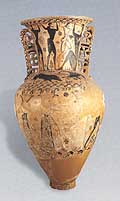
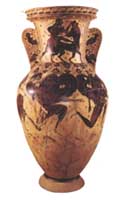 Greek pots
and vases were painted by skilled artists, but they were also strong and practical. They
were not treated as ornaments, but were made only for daily use. Here is a guide to help
you recognize the main shapes and styles. The protogeometric style dates from 100 to 900
BC. Look out for circles or semi-circles on the design. Later is the style with the
geometric patterns, dating from 900-700 BC. The 6th century BC was the period of the
orientalizing style, influenced by the East. The decoration includes animals and plants.
Greek pots
and vases were painted by skilled artists, but they were also strong and practical. They
were not treated as ornaments, but were made only for daily use. Here is a guide to help
you recognize the main shapes and styles. The protogeometric style dates from 100 to 900
BC. Look out for circles or semi-circles on the design. Later is the style with the
geometric patterns, dating from 900-700 BC. The 6th century BC was the period of the
orientalizing style, influenced by the East. The decoration includes animals and plants.
Black-figure ware -black figures on a reddish background- was produced between
600 and 530 BC.
Red figure ware -red figures on a black background- dates from 530 BC. Figures
painted on a white background are found on vases dating from 500 BC.
Some potters made cups in the form of animal or human heads. From about 400 BC, the
standard of pottery declined. Pots either imitated metal vases, or were fussy and
over-decorated.
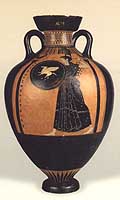 Recognizing
shapes
Recognizing
shapes
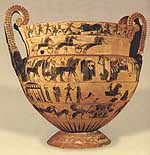 Amphorae
were used for storing wine. They are one of the most common types of pot. A stamnos
and a pelike were also storage jars. The Greeks drank wine mixed with water, which
was served from a jug, such as an olpe or an oinochoe. Some cups were large, so
that they could be passed round all the guests at a ceremony. The handles were designed so
that people lying on couches could hold them easily. Greek women carried water in a jar,
called a hydria. It was specially designed with three handles. Kraters and volute kraters
were bowls for mixing wine and water. Oils and perfumes were kept in small bottles, like
an
Amphorae
were used for storing wine. They are one of the most common types of pot. A stamnos
and a pelike were also storage jars. The Greeks drank wine mixed with water, which
was served from a jug, such as an olpe or an oinochoe. Some cups were large, so
that they could be passed round all the guests at a ceremony. The handles were designed so
that people lying on couches could hold them easily. Greek women carried water in a jar,
called a hydria. It was specially designed with three handles. Kraters and volute kraters
were bowls for mixing wine and water. Oils and perfumes were kept in small bottles, like
an 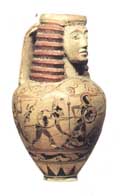 aryballos,
an alabastron and a lekythos. Pyxis used for storing cosmetics.
aryballos,
an alabastron and a lekythos. Pyxis used for storing cosmetics.

 Greek pots
and vases were painted by skilled artists, but they were also strong and practical. They
were not treated as ornaments, but were made only for daily use. Here is a guide to help
you recognize the main shapes and styles. The protogeometric style dates from 100 to 900
BC. Look out for circles or semi-circles on the design. Later is the style with the
geometric patterns, dating from 900-700 BC. The 6th century BC was the period of the
orientalizing style, influenced by the East. The decoration includes animals and plants.
Greek pots
and vases were painted by skilled artists, but they were also strong and practical. They
were not treated as ornaments, but were made only for daily use. Here is a guide to help
you recognize the main shapes and styles. The protogeometric style dates from 100 to 900
BC. Look out for circles or semi-circles on the design. Later is the style with the
geometric patterns, dating from 900-700 BC. The 6th century BC was the period of the
orientalizing style, influenced by the East. The decoration includes animals and plants.  Recognizing
shapes
Recognizing
shapes
